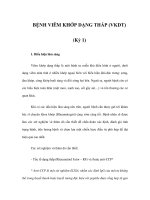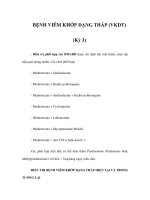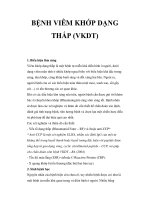Bệnh viêm khớp dạng thấp
Bạn đang xem bản rút gọn của tài liệu. Xem và tải ngay bản đầy đủ của tài liệu tại đây (5.9 MB, 53 trang )
<span class="text_page_counter">Trang 1</span><div class="page_container" data-page="1">
<b>BỆNH VIÊM KHỚP DẠNG THẤP </b>
<b>PGS.TS.BS. NGUYỄN THỊ NGỌC LANGIẢNG VIÊN CAO CẤP TRƯỜNG ĐẠI HỌC Y HÀ NỘIPHÓ CHỦ TỊCH HỘI THẤP KHỚP HỌC VIỆT NAM VRA</b>
</div><span class="text_page_counter">Trang 2</span><div class="page_container" data-page="2"><b>MỤC TIÊU</b>
TRÌNH BÀY ĐƯỢC VỀ BỆNH VIÊM KHỚP DẠNG THẤP ICD 10: M05-M06
1.CƠ CHẾ BỆNH SINH
2.CHẨN ĐOÁN VÀ CHẨN ĐOÁN PHÂN BIỆT
NÊU ĐƯỢC TIÊU CHUẨN CHẨN ĐOÁN THEO ACR 1987/ EULAR- ACR 2010 3. CÁC PHƯƠNG PHÁP ĐÁNH GIÁ MỨC ĐỘ HOẠT ĐỘNG CỦA BỆNH
4. CÁC THUỐC ĐIỀU TRỊ BỆNH VIÊM KHỚP DẠNG THẤP
</div><span class="text_page_counter">Trang 4</span><div class="page_container" data-page="4"><b>Viêm khớp dạng thấp là bệnh tự miễn</b>
<b>viêm khớp mạn tính kết hợp với biểu hiện toàn thân</b>
1Smolen J, et al. Nat Rev Drug Disc 2003; 2:473–488. 2Grassi W, et al. Eur J Radiol 1998; 27 (Suppl. 1):S18–24. 3Firestein G. Nature 2003; 423:356–361. 4Smolen J, et
al. Lancet 2007; 370:18611874. 5Turesson C, et al. Ann Rheum Dis 2004; 63:952–
955. 6del Rincón I, et al. Arthritis Rheum 2001; 44:2737–2745.
7Hochberg M, et al. Curr Med Res Opin 2008; 24:469–480. 8Peeters H, et al. Ann Rheum Dis 1996; 55:162168.9Smitten A, et al. Arthritis Res Ther 2008; 10:R45. 10Di Munno O & Delle Sedie A. J Endocrinol Invest 2008; 31 (Suppl. 7):43–47.
</div><span class="text_page_counter">Trang 5</span><div class="page_container" data-page="5"><b>CƠ CHẾ BỆNH SINH VIÊM KHỚP DẠNG THẤP</b>
<b>McInnes & Schett. NEJM 2011;365:2205-19.</b>
<b>• Sự tương tác giữa gen và mơi trường</b>
=> mất dung nạp đối với các protein Citrulline • Phản ứng kháng protein citrulline có thể được
phát hiện bởi tế bào T và B và có khả năng được khởi đầu ở
hạch lympho hoặc tủy xương
<b>• Sau đó, phản ứng viêm xảy ra ở khớp</b>
do các cơ chế có thể liên quan đến + mao mạch,
+ thần kinh, + sinh hóa
+ hoặc những con đường khác.
<b>• Viêm màng hoạt dịch</b>bắt đầu và duy trì bởi vịng phản hồi tích cực
(positive feedback loops )
từ đó thúc đẩy các rối loạn hệ thống => các triệu chứng chứng VKDT
<small>ACPA= anti–citrullinated protein antibody; RF= rheumatoid factor</small>
</div><span class="text_page_counter">Trang 6</span><div class="page_container" data-page="6"><b>TIẾN TRIỂN TỰ NHIÊN CỦA BỆNH VIÊM KHỚP DẠNG THẤP</b>
<b>Cope. Best Practice Res Clin Rheum 2017; epub 11SEP class="text_page_counter">Trang 7</span><div class="page_container" data-page="7">
<b>CƠ CHẾ BỆNH SINH BỆNH VIÊM KHỚP DẠNG THẤP</b>
</div><span class="text_page_counter">Trang 8</span><div class="page_container" data-page="8"><b>Arthroscopy</b>
</div><span class="text_page_counter">Trang 11</span><div class="page_container" data-page="11"><b>BỆNH VIÊM KHỚP DẠNG THẤP DI CHỨNG </b>
</div><span class="text_page_counter">Trang 13</span><div class="page_container" data-page="13"><b>BỆNH VIÊM KHỚP DẠNG THẤPTRIỆU CHỨNG NGOÀI KHỚP</b>
</div><span class="text_page_counter">Trang 14</span><div class="page_container" data-page="14"><b>BỆNH VIÊM KHỚP DẠNG THẤPTRIỆU CHỨNG NGOÀI KHỚP</b>
</div><span class="text_page_counter">Trang 15</span><div class="page_container" data-page="15"><b>BỆNH VIÊM KHỚP DẠNG THẤPTRIỆU CHỨNG CẬN LÂM SÀNG</b>
<b>• HỘI CHỨNG VIÊM</b>
Tốc độ máu lắng và/hoặc CRP tăng Hội chứng thiếu máu do viêm
<b>• HỘI CHỨNG MIỄN DỊCH</b>
<b>RF /và hoặc</b>
<b>Anti CCP anti cyclic citrullinated peptide): tăng</b>
</div><span class="text_page_counter">Trang 16</span><div class="page_container" data-page="16"><b>BỆNH VIÊM KHỚP DẠNG THẤPTRIỆU CHỨNG XQ</b>
<b>HÌNH BÀO MỊN</b>
</div><span class="text_page_counter">Trang 21</span><div class="page_container" data-page="21">Phát hiện tổn thương sớm trên siêu âm
<b>Paula Gould.MRI and ultrasound reveal early signs of rheumatoid arthritis</b>
<b>March 10, 2009 | DI. </b>
<b>MRI,Ultrasound,ECR 2009</b>
</div><span class="text_page_counter">Trang 22</span><div class="page_container" data-page="22"><i>John A. Carrino. Home/Physician Corner/Rheumatology Rounds Online/ Round 13: Advances in Musculoskeletal Imaging: Rheumatology</i>
<b>Phát hiện tổn thương sớm trên cộng hưởng từ</b>
</div><span class="text_page_counter">Trang 23</span><div class="page_container" data-page="23"><b>CHẨN ĐOÁN BỆNH VIÊM KHỚP DẠNG THẤP</b>
Tiêu chuẩn ACR – 1987
1. Thời gian cứng khớp buổi sáng kéo dài trên 1 giờ.
2. Viêm ít nhất 3 trong số 14 khớp : ngón gần, bàn ngón tay, cổ tay, khuỷu, gối, cổ chân, bàn ngón chân ( hai bên ).
3. Trong đó có ít nhất một khớp thuộc các vị trí sau : ngón gần, bàn ngón tay, khuỷu tay.
4. Có tính chất đối xứng. 5. Hạt dưới da.
6. Yếu tố dạng thấp huyết thanh dương tính.
7. X -quang điển hình ở khối xương cổ tay ( hình bào mịn, mất chất khống đầu xương )
<i>Thời gian diễn biến của bệnh ít nhất 6 tuần.</i>
<b>Chẩn đốn xác định khi có ít nhất 4 trong 7 yếu tố.</b>
</div><span class="text_page_counter">Trang 24</span><div class="page_container" data-page="24">Tiêu chuẩn chẩn đoán VKDT ACR/EULAR 2010
A. Biểu hiện viêm tại khớp
1−3 khớp nhỏ (có hoặc khơng có biểu hiện tại các khớp lớn)**2 4−10 khớp nhỏ (có hoặc khơng có biểu hiện tại các khớp lớn)3 >10 khớp (ít nhất phải có 1 khớp nhỏ)††5 B. XN huyết thanh (ít nhất phải có 1 XN)
RF âm tính và Anti CCP âm tính0 RF dương tính thấp hoặc Anti CCP dương tính thấp2 RF dương tính cao hoặc Anti CCP dương tính cao3 C. Các phản ứng xảy ra trong đợt cấp (ít nhất phải có 1 XN)
<i>CRP bình thường và/hoặc tốc độ máu lắng bình thường</i>0
<i>CRP tăng và/ hoặc tốc độ máu lắng tăng</i>1D. Thời gian của triệu chứng
</div><span class="text_page_counter">Trang 25</span><div class="page_container" data-page="25">CHẨN ĐOÁN PHÂN BIỆT
LUPUS BAN ĐỎ HỆ THỐNG
</div><span class="text_page_counter">Trang 26</span><div class="page_container" data-page="26">CHẨN ĐỐN PHÂN BIỆT
GÚT MẠN TÍNH
</div><span class="text_page_counter">Trang 27</span><div class="page_container" data-page="27">CHẨN ĐỐN PHÂN BIỆT
GÚT MẠN TÍNH
</div><span class="text_page_counter">Trang 28</span><div class="page_container" data-page="28">CHẨN ĐỐN PHÂN BIỆT
THỐI HĨA KHỚP NHỎ BÀN TAY
hạt Heberden
</div><span class="text_page_counter">Trang 29</span><div class="page_container" data-page="29">ĐIỀU TRỊ
BỆNH VIÊM KHỚP DẠNG THẤP
</div><span class="text_page_counter">Trang 31</span><div class="page_container" data-page="31"><b>KHÁI NIỆM CỬA SỔ CƠ HỘI ĐIỀU TRỊ</b>
<b>Điều trị sớm và tích cực</b>
•Hiệu quả tốt trên kết quả điều trị lâu dài của bệnh nhân•Ngăn chặn sự phá hủy không hồi phục của bệnh VKDT
</div><span class="text_page_counter">Trang 33</span><div class="page_container" data-page="33"><b>Yếu tố tiên lượng xấu trong VKDT</b>
• Số lượng khớp đau và khớp sưng nhiều
• Thời gian hoạt động của bệnh kéo dài ≥ 1 năm
<b>• Hình ảnh bào mịn trên Xquang xuất hiện sớm• RF /và hoặc Anti CCP cao</b>
<b>• Tốc độ máu lắng và/hoặc CRP cao</b>
• Khởi bệnh sớm trước 30 tuổi hoặc muộn • Nữ
• HLA-DR4 (+)• Hút thuốc
</div><span class="text_page_counter">Trang 34</span><div class="page_container" data-page="34">Mức đợ đau theo thang điểm VAS theo ba mức độ: + Từ 0 (mm) : Không đau => 0 điểm
+ Từ 10 đến 40 (mm) : Đau nhẹ => 1 đến 3 điểm + Từ 50 đến 60 (mm) : Đau vừa=> 4 đến 7 điểm
+ Từ 70 đến 100 (mm): Đau nặng=> 7 đến 10 điểm
<b>Đánh giá đau theo thang điểm VAS visual analogue scale </b>
</div><span class="text_page_counter">Trang 35</span><div class="page_container" data-page="35">Thang từ 0-10 đánh giá hoạt tính của bệnh
•DAS 28 # 5,1: hoạt tính bệnh cao (bệnh nặng)
•VAS 100mm (hay tình trạng chung –GH)
28 KHỚP: KHỚP MỎM CÙNG VAI, KHỚP KHUỶU TAY, CỔ TAY, BÀN NGÓN TAY 1 ĐẾN 5, KHỚP NGÓN GẦN BÀN TAY TỪ 1 ĐẾN 5, KHỚP GỐI (TÍNH CẢ HAI BÊN)
<b>Phần mềm tính tốn DAS: INTENET</b>
<b>DAS 28 + [ 0,56 (SỐ KHỚP ĐAU)+ 0,28 (SỐ KHỚP SƯNG)+ 0,70LN (MÁU LẮNG GIỜ ĐẦU)] 1,08 + 0,16</b>
<b>ĐÁNH GIÁ MỨC ĐỘ HOẠT ĐỘNG BỆNH THEO DAS 28- Disease activity score</b>
</div><span class="text_page_counter">Trang 36</span><div class="page_container" data-page="36"><b>2. CDAI</b>
<b>3. SDAI</b>
<b>-Là Chỉ số hoạt động bệnh trên lâm sàng The Clinical Disease Activity Index </b>
<b>- CDAI = SJC + TJC + PtGA + PrGA </b>
<b>- Là Chỉ số hoạt động bệnh đơn giản</b>
<b>The Simplified Disease Activity Index</b>
<b>- SDAI = SJC + TJC + PtGA + PrGA + CRP</b>
</div><span class="text_page_counter">Trang 37</span><div class="page_container" data-page="37"><b>Sự lui bệnh</b>
<b>MỤC TIÊU ĐIỀU TRỊ BỆNH VIÊM KHỚP DẠNG THẤP</b>
<b>Giảm hoặc ngănviêm</b>
<b>Kết quả X quang1</b>
<b>Tối ưu hóa</b>
<b>chất lượng cuộc sống3</b>
<b>Ngăn sự phá hủy khớp</b>
<b>3</b><b>Duytrì chức năng,khả năng làm việcvà ngăn sự tàn phế</b>
<b>3</b><b>Tối ưu hóa</b>
<b>chất lượng cuộc sống3</b>
<i><b><small>1. Combe B, et al. Ann Rheum Dis. 2007;66:34-45. 2. Mader R, Keystone E. J Rheumatol. </small></b></i>
<b><small>2007;34:16-24. </small></b>
<i><b><small>3. American College of Rheumatology (ACR). Arthritis Rheum. 2002;46:328-346. </small></b></i>
<b>QoL, quality of life; ADL, activities of daily living.</b>
</div><span class="text_page_counter">Trang 38</span><div class="page_container" data-page="38">KHUYẾN CÁO ĐIỀU TRỊ NHẮM ĐÍCH T<b>reat to target (T2T)</b>
• EULAR
<b>– Lui bệnh: </b>đặc biệt là trong VKDT giai đoạn sớm
<b>– Hoạt tính bệnh thấp (LDA)</b>: ở các BN đã bị bệnh lâu dài • ACR
<b>– Hoạt tính bệnh thấp LDA hoặc lui bệnh</b>
khuyến cáo đốI với mọi BN VKDT mọi giai đoạn (sớm hoặc muộn)
điều trị bằng DMARD hoặc thuốc sinh học
Điều trị sớm (với DMARDS)- hoặc thuốc sinh học
Bất kỳ sự trì hỗn nào đều ảnh hưởng xấu tới kết cục => tận dụng “cửa sổ cơ hội” LDA = low disease activity
<i><b>1. Smolen JS, et al. Ann Rheum Dis 2010; 69:631</b></i>637.
<i><b>2. Smolen JS, et al. Ann Rheum Dis 2010; 69:964–975.3. Singh JA , et al. Arthritis Rheum 2012; 64:625–639</b></i>
<small>.</small></div><span class="text_page_counter">Trang 39</span><div class="page_container" data-page="39"><b>CÁC THUỐC ĐIỀU TRỊ VIÊM KHỚP DẠNG THẤP</b>
<small>1</small><i><b><small>. ACR Subcommittee on Rheumatoid Arthritis Guidelines. Arthritis Rheum 2002; 46:328–346.2. Pollard L, et al. Clin Exp Rheumatol 2005; 23:S43–S52.</small></b></i>
<i><b><small>3. Gaffo A, et al. Am J Health Syst Pharm 2006; 63:2451–2465</small></b></i><small>.</small>
<b>Th́c giảm triệu chứng</b>
<b><small>3</small></b>•Traditional NSAIDs- COX-2 inhibitors
•Giảm đau
<b>Thuốc điều trị cơ bản- điều trị nền</b>
<b>làm chậm tổn thương khớp</b>
<b>và giảm các triệu chứng bệnh</b>
<b><small>3</small></b></div><span class="text_page_counter">Trang 40</span><div class="page_container" data-page="40">ĐIỀU TRỊ BỆNH VIÊM KHỚP DẠNG THẤP Khuyến cáo EULAR 2019
Phác đồ tổng thể
should be part of the first treatment strategy. While combination therapy of csDMARDs is not preferred by the Task Force, starting with MTX does not exclude its use in combination with other csDMARDs although more adverse events without added benefit are to expected, especially if MTX is
according to ACR-EULAR definitions or, if remission is unlikely to be achievable, at least LDA; the target should be reached after 6 months, but therapy should be adapted or changed if insufficient improvement
EMA/FDA approved bsDMARDs), ABT, IL-6R inhibitors, or RTX (under certain conditions); in pts who cannot use csDMARDs as comedication,
increase can be safely done with all bDMARDs and tsDMARDs with little risk of flares; stopping is associated with high flare rates, most but not all pts can recapture their good state upon re-institution of the same
failure is not fully known; also, efficacy and safety of an IL-6 pathway inhibitor after another one has failed is currently unknown. Efficacy and safety of a JAK inhibitor after insufficient response to a previous JAK inhibitor is unknown
Smolen et al. Ann Rheum Dis 2020, epub 22 JAN; doi: 10.1136/annrheumdis-2019-216655
<small>.</small></div><span class="text_page_counter">Trang 41</span><div class="page_container" data-page="41"><b>Cải thiện ở tháng thứ 3 và đạt được mục tiêu ở </b>
<small>1</small>2010 ACR-EULAR classification criteria can support early diagnosis; <small>2</small>MTX should be part of the first treatment strategy. While combination therapy of csDMARDs is not preferred by the Task Force, starting with MTX does not exclude its use in combination with other csDMARDs although more adverse events without added benefit are to expected, especially if MTX is combined with glucocorticoids. <small>3</small>The treatment target is clinical remission according to ACR-EULAR definitions or, if remission is unlikely to be achievable, at least LDA; the target should be reached after 6 months, but therapy should be adapted or changed if insufficient improvement (<50% of disease activity) is seen after 3 months; <small>4</small>Sustained remission ≥6 months ACR/EULAR index based
</div><span class="text_page_counter">Trang 42</span><div class="page_container" data-page="42"><b>Pha II</b>
<b>Không cải thiện ở thángthứ 3 và không đạt được</b>
<b>Cải thiện ở tháng thứ3 & đạt mục tiêu luibệnh ở tháng thứ 6?<small>3</small></b>
<b>CóTiếp tục</b>
<b>Giảm liều khi đạt lui bệnh bền vững</b>
<b><small>4</small></b><i><b>Có yếu tố tiên lượng xấu</b></i>
<b>Cải thiện ở tháng thứ 3 & đạt mục tiêu lui bệnh</b>
<small>3</small>The treatment target is clinical remission according to ACR-EULAR definitions or, if remission is unlikely to be achievable, at LDA; the target should be reached after 6 months, but therapy should be adapted or changed if insufficient improvement (<50% of disease activity) is seen after 3 months; <small>4</small>Sustained remission ≥6 months ACR/EULAR index based on Boolean remission; <small>5</small>Consider contraindications and risks; <small>6</small>The most frequently used combination comprises MTX, SSZ and HCQ; <small>7</small>TNFi (ADA, CZP, ETN, GLM, incl. EMA/FDA approved bsDMARDs), ABT, IL-6R inhibitors, or RTX (under certain conditions); in pts who cannot use csDMARDs as comedication, IL-6i and tsDMARDs have some advantages; <small>8</small>Dose reduction or interval increase can be safely done with all bDMARDs and tsDMARDs with little risk of flares; stopping is associated with high flare rates, most but not all pts can recapture their good state upon re-institution of the same bDMARD/tsDMARD
<b>Smolen et al. Ann Rheum Dis 2020, epub 22 JAN; doi: 10.1136/annrheumdis-2019-216655</b>
<b><small>.</small></b>Xin lưu ý sử dụng ≥2 csDMARDs được xem như
là có yếu tố tiên lượng xấu
Mục tiêu là đạt lui bệnh kéo dài hay hoạt tính bệnh thấp
</div><span class="text_page_counter">Trang 43</span><div class="page_container" data-page="43"><b>Giai đoạn III</b>
<b>Khơng cải thiện ở tháng thứ 3 vàđạt mục tiêu lui bệnh ở pha II</b>
<b>JAK inhibitor</b>
<b><small>5,9</small></b><b>(loại khác hay cùng nhóm)</b>
<b>Cải thiện ở tháng thứ 3 và đạtmục tiêu lui bệnh ở tháng thứ 6?</b>
<b><small>3</small></b><b>CóTiếp tục</b>
<b>Giảm liều/ giãn liều khi đạt luibệnh bền vững</b>
<b><small>4</small></b><small>3</small>
The treatment target is clinical remission according to ACR-EULAR definitions or, if remission is unlikely to be achievable, at LDA; the target should be reached after 6 months, but therapy should be adapted or changed if insufficient improvement (<50% of disease activity) is seen after 3 months;
<small>4</small>Sustained remission ≥6 months ACR/EULAR index based on Boolean remission;
<small>5</small>Consider contraindications and risks;
<small>8</small>
Dose reduction or interval increase can be safely done with all bDMARDs and tsDMARDs with little risk of flares; stopping is associated with high flare rates, most but not all pts can recapture their good state upon re-institution of the same bDMARD/tsDMARD;
<small>9</small>Efficacy and safety of bDMARDs after JAK inhibitor failure is not fully known; also, efficacy and safety of an IL-6 pathway inhibitor after another one has failed is currently unknown. Efficacy and safety of a JAK inhibitor after insufficient response to a previous JAK inhibitor is unknown
ĐIỀU TRỊ BỆNH VIÊM KHỚP DẠNG THẤP -Khuyến cáo EULAR 2019
Phác đồ tổng quát Pha III
<b>Smolen et al. Ann Rheum Dis 2020, epub 22 JAN; doi: 10.1136/annrheumdis-2019-216655</b>
<b><small>.</small></b>Mục tiêu là lui bệnh bền vữnghay hoạt tính bệnh thấp
</div><span class="text_page_counter">Trang 44</span><div class="page_container" data-page="44"><b>Chiến lược điều trị bệnh viêm khớp dạng thấp : Treat to target </b>
1.Xác định mục tiêu điều trị và chọn lựa thuốc phù hợp
2.Đánh giá kết quả điều trị
3.Duy trì hoặc điều chỉnh điều trị
<small>4. Đánh giá sau 1 – 3 tháng, khi bệnh đang hoạt động</small>
<small>5. Nếu không cải thiện sau 3 tháng, hoặc không đạt mục tiêu sau 6 tháng, phải thay đổi điều trị</small>









